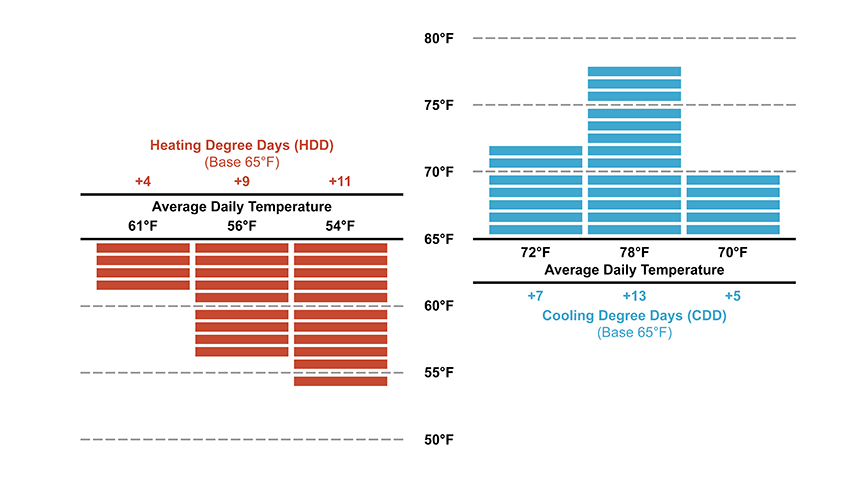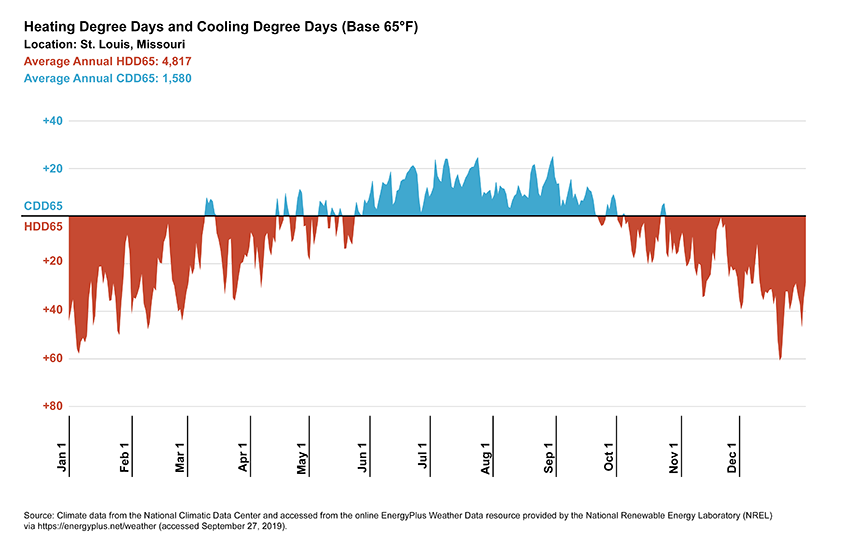There are many ways of gauging the relative heating and/or cooling needs of a building due to the local climate. However, a long-established metric is the "degree day."
Degree Days, Base Temperature, and Balance Point Temperature
Degree days are used to record the difference between the base temperature and the average ambient temperature for a given day at a specific location.
Degree days are defined relative to a base temperature. It is against the base temperature (typically 65 degrees Fahrenheit for a conventionally-heated and cooled house) that the average ambient daily temperature is compared for the purpose of degree day calculations. The base temperature is equal to the average of all hourly balance point temperatures throughout the heating or cooling season for a building.
The balance point temperature (BPT) is the outdoor temperature at which the amount of heat generated inside of a building balances its heat exchange through the building envelope to maintain a desired interior temperature. In other words, at this maintained BPT, no additional heating or cooling inputs would be required. Of course, outdoor temperatures are constantly fluctuating—as are interior heat gains from people, equipment, lighting, etc. This means that the actual BPT is constantly shifting. This also means that the base temperature for the heating season may not be the same for the cooling season. Certain seasonal activities within a structure, the utilization of passive systems, etc. can all shift these figures—perhaps a structure's base temperature is 65F during the heating season but 50F during the cooling season.
For convenience regarding the information that follows, let us assume a consistent base temperature of 65F.
Heating Degree Days (HDD) and Cooling Degree Days (CDD).
If the average ambient temperature for the day is below the base temperature, then heating is required and the difference (in degrees) is recorded as heating degree days (HDD) for that specific day.
If the average ambient temperature for the day is above the base temperature, then cooling is required and the difference (in degrees) is recorded as cooling degree days (CDD) for that specific day.
Consider the following example (Figure 1). If the base temperature is 65F and the average daily temperature is 61F, then 4 heating degree days would be recorded for that day. If the next day, the average temperature drops to 56F, then 9 heating degree days would be recorded. The total heating degree days for a given location is the summation of all heating degree days recorded over the course of a year.
Similarly, during the cooling season the average daily temperatures will be above the base temperature and thus cooling degree days would be recorded and the total cooling degree days may be determined.
|
Figure 1: Heating degree days (HDD) and cooling degree days (CDD) are determined daily based on the average ambient temperature relative to an established base temperature. |
Over the course of a year, the totality of HDD and CDD provides a useful metric to gauge the heating and cooling energy demand for a given location. Consider the following example (Figure 2) in which the average ambient temperature of St. Louis, Mo., is measured against a consistent base temperature of 65F. The average annual HDD65 of 4,817 is much greater than the average annual CDD65 of 1,580 and puts into perspective the city's dominant heating requirement for buildings with such seasonal base temperatures.
|
Figure 2: Average heating degree days (HDD65) and cooling degree days (CDD65) for St. Louis, Mo. |




Recent Comments
These are actually very helpful tips. It is...
This is the most beneficial blog for all...
This blog is a great resource for anyone...
Thank you for sharing this important information. I...
This is a very interesting subject of the...